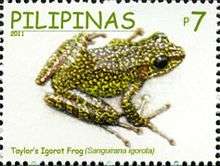Sanguirana igorota
Sanguirana igorota is a species of true frog, family Ranidae. It is endemic to Cordillera Central of the island of Luzon, Philippines.[1][2] Its closest relative is Sanguirana luzonensis, and it has even been considered synonym of that species;[2] a later study suggests still unresolved relationships between S. igorota, S. luzonensis, and S. tipanan.[3] Common name Taylor's Igorot frog has been coined for this species.[4]
| Sanguirana igorota | |
|---|---|
 | |
| Scientific classification | |
| Kingdom: | Animalia |
| Phylum: | Chordata |
| Class: | Amphibia |
| Order: | Anura |
| Family: | Ranidae |
| Genus: | Sanguirana |
| Species: | S. igorota |
| Binomial name | |
| Sanguirana igorota (Taylor, 1922) | |
| Synonyms[2] | |
| |
Description
Adult males measure 50–58 mm (2.0–2.3 in) and adult females 68–82 mm (2.7–3.2 in) in snout–vent length.[3] The snout is squarish in dorsal view.[3][5] The tympanum can be translucent.[3] Moderate dorsolateral ridges are present. The dorsum is olive green with bronze spots. The venter is yellow.[3][5] Fine dorsal asperities are present. The groin is tuberculate. No vocal sac is present in males.[3]
Habitat and conservation
Sanguirana igorota occurs in cool streams and rivers in montane rainforest at elevations of 850–950 m (2,790–3,120 ft) above sea level[1] (800–1,300 m (2,600–4,300 ft) in other sources[4]). It can be fairly abundant in suitable habitat and tolerates some habitat disturbance. Presumably, breeding takes place in streams; the eggs are laid in water. It is threatened by habitat loss (deforestation) caused by habitat conversion to agriculture or real estate.[1]
References
- Arvin Diesmos; Angel Alcala; Rafe Brown; Leticia Afuang; Cynthia Dolino; Genevieve Gee; Katie Hampson; Mae Leonida Diesmos; Aldrin Mallari; Perry Ong; Liza Paguntalan; Marisol Pedregosa; Dondi Ubaldo & Baldwin Gutierrez (2004). "Sanguirana igorota". IUCN Red List of Threatened Species. 2004: e.T58623A11814424. doi:10.2305/IUCN.UK.2004.RLTS.T58623A11814424.en.
- Frost, Darrel R. (2018). "Sanguirana igorota (Taylor, 1922)". Amphibian Species of the World: an Online Reference. Version 6.0. American Museum of Natural History. Retrieved 28 May 2018.
- Brown, Rafe M.; Prue, Allyson; Onn, Chan Kin; Gaulke, Maren; Sanguila, Marites B. & Siler, Cameron D. (2017). "Taxonomic reappraisal of the Northeast Mindanao Stream Frog, Sanguirana albotuberculata (Inger 1954), validation of Rana mearnsi, Stejneger 1905, and description of a new species from the central Philippines". Herpetological Monographs. 31 (1): 210–231. doi:10.1655/HERPMONOGRAPHS-D-16-00009.1.
- Diesmos, Arvin C. (2 Sep 2014). "The Igorot frog". Philippine Daily Inquirer. Retrieved 22 May 2018.
- Brown, Rafe M.; McGuire, Jimmy A. & Diesmos, Arvin C. (2000). "Status of some Philippine frogs referred to Rana everetti (Anura: Ranidae), description of a new species, and resurrection of Rana igorota Taylor". Herpetologica. 56 (1): 81–104. JSTOR 3893130.
| Wikimedia Commons has media related to Hylarana igorota. |
